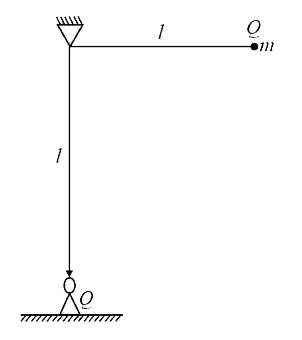Below the fixed end O of the insulating horizontal thread OB, there is a fixed charge A of Q=20μc. At the end B of the thread there is a small mass m carrying charge Q=20moc. The mass is released from the position shown and it is found to come to rest when the thread becomes vertical. Assume that the thread does not hit the fixed charge at A. [g=10m/s2] (a) Find mass m. (b) Find tension in the thread in the equilibrium position when the thread is vertical. (c) Is the equilibrium mentioned in (b) stable or unstable?
![Below the fixed end O of the insulating horizontal thread OB, there is a fixed charge A of Q = 20muc. At the end B of the thread there is a small mass m carrying charge Q = 20moc. The mass is released from the position shown and it is found to come to rest when the thread becomes vertical. Assume that the thread does not hit the fixed charge at A. [g = 10 m//s^2] (a) Find mass m. (b) Find tension in the thread in the equilibrium position when the thread is vertical. (c) Is the equilibrium mentioned in (b) stable or unstable?](https://d10lpgp6xz60nq.cloudfront.net/physics_images/IJA_PHY_V02_C06_E01_096_Q01.png)
The correct Answer is:(a). 72g
(b). 4.32N
(c) unstable
Step by step video, text & image solution for Below the fixed end O of the insulating horizontal thread OB, there is a fixed charge A of Q = 20muc. At the end B of the thread there is a small mass m carrying charge Q = 20moc. The mass is released from the position shown and it is found to come to rest when the thread becomes vertical. Assume that the thread does not hit the fixed charge at A. [g = 10 m//s^2] (a) Find mass m. (b) Find tension in the thread in the equilibrium position when the thread is vertical. (c) Is the equilibrium mentioned in (b) stable or unstable? by Physics experts to help you in doubts & scoring excellent marks in Class 12 exams.
Topper's Solved these Questions
- BOOK - ARIHANTCHAPTER - ELECTROSTATICSEXERCISE - Level 359videos
ELECTROSTATICS
- BOOK - ARIHANTCHAPTER - ELECTROSTATICSEXERCISE - Level 359videos
ELECTROSTATICS
- BOOK - ARIHANTCHAPTER - ELECTROMAGNETIC INDUCTIONEXERCISE - Level 312videos
ELECTROMAGNETIC INDUCTION
- BOOK - ARIHANTCHAPTER - GEOMETRICAL OPTICSEXERCISE - Level 39videos
GEOMETRICAL OPTICS
Similar Questions
Two identical spheres of mass m and charge q are suspended from a common point by two threads of the same length l and it is found that threads make an angle θ with the vertical when the spheres are in equilibrium . Calculate the value of q.
View SolutionTwo idential pith balls , each of mass m and charge +q. are suspended from a point with threads of length l each. If in equiilbrium state θ be the angle which each thread makes with vertical in equilibrium , find value of charge on each ball.
View Solution
Knowledge Check
- Question 1 - Select One
Below the fixed end of the insulating horizontal thread, at a distance equal to the length (10 cm) of the thread there is a fixed charge, which has the same charge as the charge (1μC) of the small body of mass m at the end of the thread as shown in the figure. The body is released and when it is at the lowest position the angle between the thread and the horizontal is 30∘. The mass of the moving body is closest to :
 A54 gB108 gC0.54 gD10..8g
A54 gB108 gC0.54 gD10..8g - Question 2 - Select One
If a small sphere of mass m and charge q is hanged from a silk thread at an angle θ with the surface of a vectical charged conductinb plate, then for equilibrium of sphere the surface charge density of the plate -
Aε0mgtanθqB(2ε0mgtanθ)/qCε0mgqtanθDε0mgtanθ3q - Question 3 - Select One
A particle of mass m is whirled in a vertical circle with the help of a thread. If− the maximum tension in the thread is double its minimum value then the value of minimum tension in the thread will be:
A6 mgBzeroC3 mgDcan't be found
A particle of mass 100 gm and charge 2μC is released from a distance of 50 cm from a fixed charge of 5μC. Find the speed of the particle when its distance from the fixed charge becomes 3 m.
View SolutionA particle of mass 100 gm and charge 2μC is released from a distance of 50 cm from a fixed charge of 5μC. Find the speed of the particle when its distance from the fixed charge becomes 3 m.
View SolutionA small sphere of mass m suspended by a thread is first taken a side so that the thread forms the right angle with the vertical and then released, then
View SolutionIf a small sphere of mass m and charge q is hung from a silk thread at an angle θ with the surface of a vertical charged conducting plate, then for equilibrium of sphere, the surface charge density of the plate is
View SolutionA charged particle of charge 'Q' is held fixed and another charged particle of mass 'm' and charge 'q' (of the same sign) is released from a distance 'r'. The impulse of the force exerted by the external agent on the fixed charge by the time distance between 'Q' and 'q' becomes 2r is
View Solution

